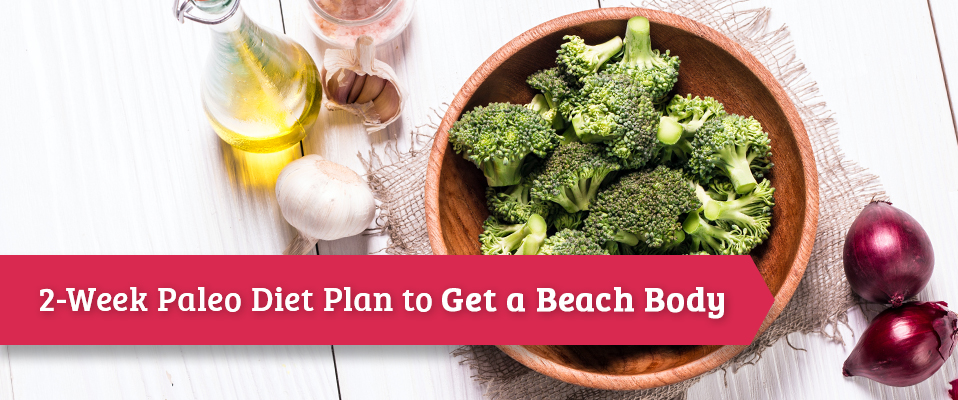
If you’re ready to get in shape for the summer, adopting a Paleo diet may be the way to help you get the beach body of your dreams. This popular diet plan has attracted fans from around the globe who say a Paleo style of eating helps them stay slim and healthy while boosting their overall energy levels.
Paleo Diet Basics
The Paleo diet was popularized by Loren Cordain, PhD, author of the best-selling book, “The Paleo Diet.” He claims the diet will help you effortlessly lose weight and reduce your risk of health problems such as diabetes, heart disease and cancer.
The Paleo diet is based on the premise that we can improve our health by modeling our food choices on what our ancestors ate. Essentially, the diet is asking you to “eat like a caveman” by forgoing fast food, sugary sweets and other modern dietary staples. If your ancestors didn’t have it available to them, it’s not available for you to eat, either.
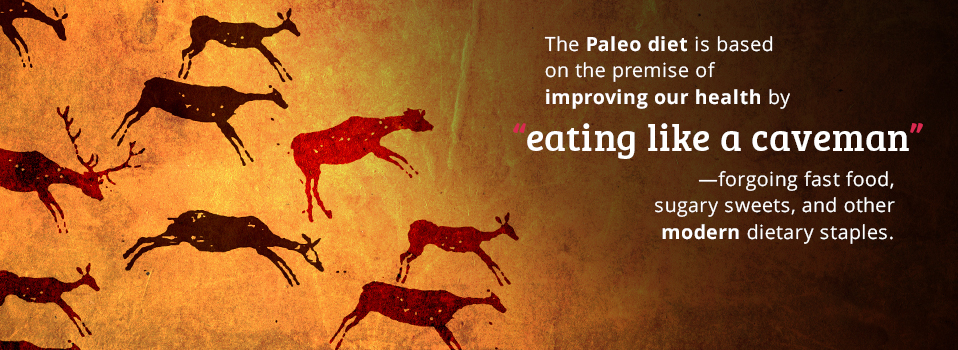
The Paleo diet is often thought of as the “meat and vegetable diet,” since you’ll be eating meals that are heavy in items from these two food groups. However, you need to select your foods carefully to make sure you’re getting all of the vitamins and minerals that are essential for optimal health.
No calorie counting is required on the Paleo diet. You’re relying on high-protein, high-fiber foods to help control your appetite. Exercising is not required while you’re trying to lose weight, although it’s strongly recommended for those who want to maintain their weight or improve their overall health.
How Much Weight Can You Lose on a Paleo Diet?
If weight loss is your primary motivation for adopting a Paleo lifestyle, you’re probably wondering how fast the pounds will come off. Unfortunately, a lot of this depends on your current eating habits and activity level. However, if you’re regularly consuming lots of processed foods with refined sugars, cutting out these empty calories should help the pounds come off without the hunger pains that are so common on most other diet plans.
The Paleo diet turns much of the commonly accepted nutritional advice on its head, but the focus on high-protein and high-fiber meals will keep you feeling full between meals. On a per-calorie basis, a Paleo meal plan is more satisfying than any other diet out there.
Before starting any diet plan, though, it’s always a good idea to meet with your healthcare provider to discuss your weight loss goals and any medical conditions that affect your nutritional needs. For example, if you suffer from diabetes, the Paleo diet will need to be adjusted to meet your specific blood glucose level requirements.
Common Issues Encountered When Adjusting to a Paleo Meal Plan
Most people are able to adapt to a Paleo meal plan with minimal discomfort. However, you should be attentive to how your body feels during the transition period.
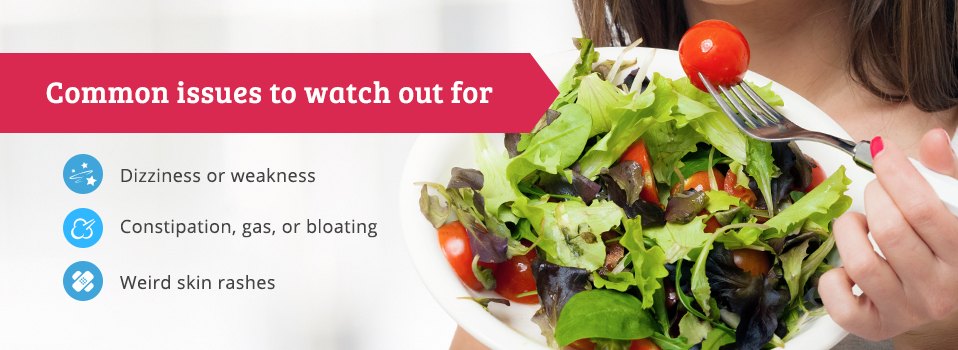
Here are some common issues to watch out for:
- Dizziness or weakness: If you were eating a high-carbohydrate diet before adopting a Paleo meal plan, a sudden reduction in carbs can cause feelings of weakness and dizziness. Eating larger portions at mealtime can help.
- Constipation, gas or bloating: People who aren’t used to eating a lot of vegetables can experience digestive issues when transitioning to a Paleo diet. Symptoms usually disappear within a few days, but they can be quite uncomfortable. If you’re bothered by ongoing issues, stick to safe veggies such as carrots, zucchini, lettuce, eggplant, spinach and cucumbers for the bulk of your meals and eliminate other veggies one-by-one to determine what’s causing the sensitivity.
- Weird skin rashes: The Paleo diet often includes high consumption of coconut products, which can cause a bad reaction in some cases. You might also have an allergy to a fruit or vegetable you weren’t regularly consuming before.
If you’re not able to resolve your issues at home within a few days, consult your healthcare provider for further guidance.
Eating Meat, Fish and Seafood While on the Paleo Diet
With the exception of hot dogs, lunch meat and other highly processed items, almost all meat is acceptable in the Paleo diet. This is because our ancestors relied heavily on animal protein to get through their days.
Some of the different meats you can enjoy while on the Paleo diet include:
- Beef
- Bison
- Buffalo
- Clams
- Turkey
- Chicken
- Elk
- Goat
- Lamb
- Lobster
- Pork
- Pheasant
- Oysters
- Quail
- Rabbit
- Tuna
- Trout
- Salmon
- Shrimp
- Walleye
When purchasing meat, it’s best to buy organic whenever possible. If you enjoy eating beef on a regular basis, look for grass-fed beef to add extra omega-3 and omega-6 fats to your diet.
Nuts and the Paleo Diet
Nuts play an important role in the Paleo diet, but those seeking to get a beach body may wish to exercise portion control. Nuts are high in calories, and it’s easy to eat more than you intended if you’re snacking while doing other things.
Also, keep in mind that peanuts are actually classified as legumes. Peanuts and peanut butter aren’t allowed on the Paleo diet.
Nuts you can enjoy on the Paleo diet include:
- Almonds
- Cashews
- Hazelnuts
- Macadamia nuts
- Pecans
- Pine nuts
- Pumpkin seeds
- Sunflower seeds
- Walnuts
Vegetables and the Paleo Diet
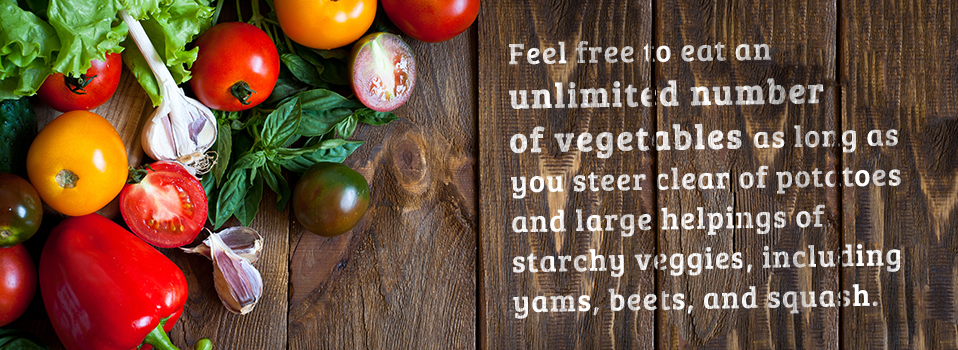
You can eat an unlimited number of vegetables on the Paleo diet, as long as you steer clear of potatoes and limit your intake of the starchy veggies like yams, beets and squash. Feel free to enjoy:
- Asparagus
- Avocado
- Artichoke hearts
- Brussels sprouts
- Broccoli
- Cabbage
- Carrots
- Celery
- Cauliflower
- Cucumbers
- Eggplant
- Green onions
- Lettuce
- Parsley
- Peppers
- Spinach
- Zucchini
Whenever possible, choose organic veggies for maximum nutritional benefit.
Fruit and the Paleo Diet
Fruit is both nutritious and delicious, but a Paleo diet seeks to consume fructose in moderation. Therefore, you should limit yourself to no more than three servings of fruit per day and focus on increasing the number of veggies in your diet. Use fruit as a snack or when you’re craving something with a bit of sweetness.

Good fruits to consume while on a Paleo diet plan include:
- Apples
- Blackberries
- Blueberries
- Cantaloupes
- Grapes
- Lemons
- Limes
- Mangoes
- Papaya
- Peaches
- Pineapple
- Plums
- Oranges
- Raspberries
- Strawberries
- Tangerines
- Watermelon
As with vegetables, it’s recommended that you purchase organic fruit whenever possible.
Paleo Oils and Fats
People who are trying to lose weight often think of fat as the enemy, but healthy fats give your body the fuel it needs to make it through the day. When cooking, use coconut oil, olive oil, avocado oil and/or macadamia oil to make your food taste delicious and give your body additional energy.
Desserts on the Paleo Diet
If you have a sweet tooth, the Paleo diet can feel rather limiting. Although cavemen didn’t indulge in cookies and cakes, you can enjoy the occasional treat if it’s prepared with Paleo-approved ingredients. Paleo desserts are made with ingredients such as honey, maple syrup, almond flour, almond milk and coconut milk. Many also incorporate fruit for natural sweetness.
Alcohol and the Paleo Diet
If you’re trying to lose weight, you’ll want to abstain from alcohol. In addition to being high in calories and low in nutritional value, beer and tequila are not considered appropriate Paleo foods. Dry wines can be enjoyed in moderation, but should not be consumed on a regular basis. As a general guide, the driest red wines are Cabernet Sauvignon, Merlot and Pinot Noir. The driest white wines are Albarino and Sauvignon Blanc.
Foods Not Allowed on the Paleo Diet
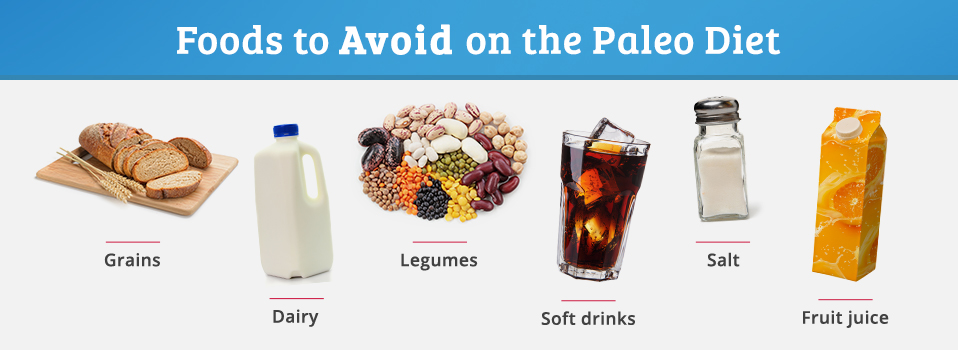
Although it’s difficult to list every food you can enjoy on a Paleo diet, it’s fairly easy to remember the list of foods you need to avoid:
- Grains: For most people, this is the toughest thing to give up. Grains include bread, pasta, breakfast cereals and processed snacks like pretzels, crackers and cookies.
- Dairy: The Paleo diet doesn’t allow milk, cheese, butter, ice cream or yogurt.
- Legumes: Legumes include all beans, as well as peas, peanuts and tofu.
- Soft Drinks: Since sugar, artificial sweeteners and high-fructose corn syrup aren’t allowed on a Paleo diet, you’ll need to say goodbye to your favorite soft drinks.
- Fruit Juice: Although fresh fruit is fine to enjoy in moderation, fruit juices are too high in fructose to be a part of the Paleo diet.
- Salt: Salt is a no-no on the Paleo diet, which makes this plan great for people with high blood pressure who need to follow a low-sodium diet.
Supplements and the Paleo Diet
You may wish to speak to your doctor about taking a supplement to fill in the gaps in your diet, especially if you tend to repeat a lot of the same Paleo meals. Supplements can help you reach your weight loss goals without sacrificing your long-term health.
It’s most common for people on a Paleo diet to supplement with vitamin D, Calcium, Folate and B12. This is because their diets don’t include enough of the most common food-based sources of these vitamins and minerals.
- Vitamin D: Large numbers of adults, regardless of what they eat, are deficient in vitamin D. The primary source of vitamin D is sunlight, but it’s also found in cheese, egg yolks, tuna, salmon and beef liver. Orange juice, soy milk, cereals and select dairy products are commonly fortified with vitamin D.
- Calcium: Calcium is found in milk, cheese, soy products and fortified cereals or breads. Smaller amounts are present in kale, bok choy and other leafy greens.
- Folate: Top sources of folate are beans, lentils, broccoli, avocados, asparagus, orange juice and wheat bread.
- Vitamin B12: Vitamin B12 is found in fortified cereals and dairy products, as well as fish, poultry, meat and eggs.
Sample 2-Week Paleo Diet Plan
A Paleo diet is very flexible, since there is no calorie counting. You just need to remember the following guidelines:
- Choose foods from the approved Paleo food list.
- Aim to eat three meals and one snack per day. However, if you’re not hungry enough for a snack, it’s fine to skip it and simply eat a larger portion at mealtime.
- When creating meals, make your vegetables at least half the plate. Try to get one or two servings of protein, and include a bit of healthy Paleo fats for energy. Fruits and nuts are optional.
- If you struggle with portion control, don’t eat while watching TV or texting. Focus solely on your food. Savor every bite and listen to your body’s natural hunger cues.
Feel free to use this example Paleo diet plan as a guideline for reaching your own weight loss goals.
Day 1
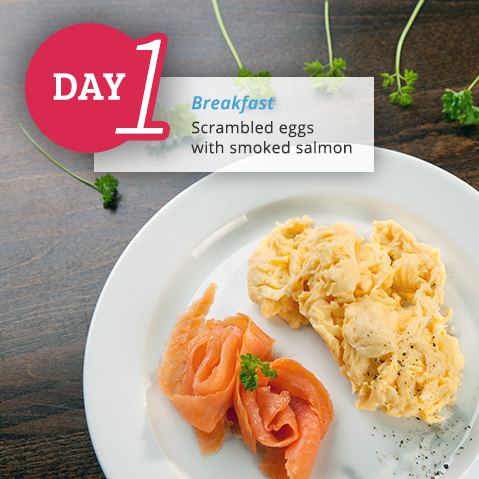
- Breakfast: Scrambled eggs with smoked salmon
- Lunch: Tuna and avocado lettuce wraps
- Dinner: Stuffed yellow squash
- Snack: Carrot sticks and macadamia nut hummus
Day 2
- Breakfast: Broccoli and egg bake
- Lunch: Vegetable beef soup
- Dinner: Spicy pepper chicken stir fry
- Snack: All natural homemade fruit roll-ups
Day 3
- Breakfast: Blueberry smoothie with almond milk
- Lunch: Taco salad with romaine lettuce replacing the standard deep fried taco shell bowl
- Dinner: Grilled chicken breasts with zucchini
- Snack: Kale chips
Day 4
- Breakfast: Pumpkin pancakes
- Lunch: Teriyaki glazed chicken kabobs
- Dinner: Beef and bok choy stir fry
- Snack: Prepackaged Paleo energy bars
Day 5
- Breakfast: Stuffed breakfast peppers
- Lunch: Chipotle chicken lettuce wraps
- Dinner: Greek style meatballs with roasted cauliflower
- Snack: Homemade apple chips
Day 6
- Breakfast: Gluten-free, dairy-free sweet potato pancakes
- Lunch: Salad with grilled chicken and veggies
- Dinner: Beef stew
- Snack: Sweet potato chips
Day 7
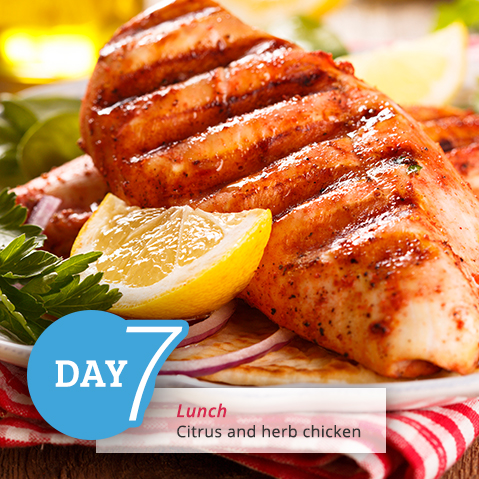
- Breakfast: Cherry tomato and basil quiche
- Lunch: Citrus and herb chicken
- Dinner: Crock pot roast with carrots, celery, and onions
- Snack: Frozen berries drizzled with coconut milk and honey
Day 8
- Breakfast: Sausage and butternut squash frittata
- Lunch: Salad with canned salmon and a mustard vinaigrette
- Dinner: Citrus marinated flank steak with a side of mixed vegetables
- Snack: Beef jerky
Day 9
- Breakfast: Eggs Benedict with artichoke hearts replacing the standard English muffin
- Lunch: Paleo beef kabobs
- Dinner: Garlic roasted cod with green beans
- Snack: Piece of your favorite fruit
Day 10
- Breakfast: Green smoothie
- Lunch: Salad with roast chicken, dried cranberries, pecans, apple slices, and a vinaigrette dressing
- Dinner: Crock pot chili
- Snack: Turkey slices rolled up with avocado
Day 11
- Breakfast: Cabbage and onions fried with bacon
- Lunch: Bell peppers stuffed with ground turkey
- Dinner: Shrimp and asparagus stir fry
- Snack: Apple slices with almond butter
Day 12
- Breakfast: Ham and egg breakfast cups
- Lunch: Roasted butternut squash soup
- Dinner: Sushi rolls
- Snack: Small amount of trail mix
Day 13
- Breakfast: Breakfast burrito with a faux tortilla make from cooked egg whites
- Lunch: Caesar salad with chicken
- Dinner: Paleo spaghetti made with spaghetti squash instead of pasta, ground turkey or ground beef meatballs, and extra veggies in the sauce
- Snack: Hard-boiled egg
Day 14
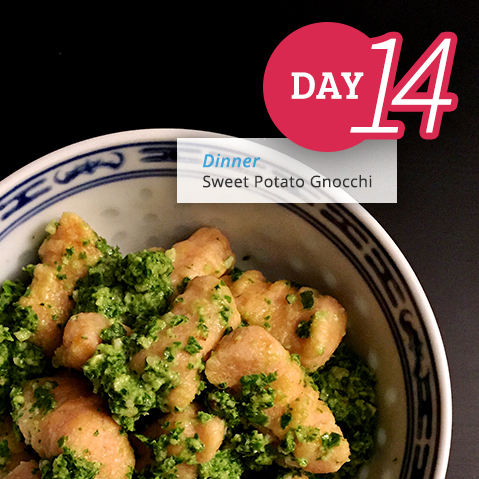
- Breakfast: Bacon and tomato quiche
- Lunch: Spicy Indian chicken stir fry
- Dinner: Sweet potato gnocchi
- Snack: Apple slices and raw walnuts
Adapting Your Favorite Recipes to a Paleo Diet
If there are certain foods you’ve been craving, you don’t necessarily need to give them up on your Paleo diet. Many recipes can be made Paleo-friendly with some tweaking. Consider the following Paleo swaps to help you get started:
- Use coconut flour, almond flour or a mixture of the two instead of all-purpose flour in baked goods.
- Use flax meal instead of breadcrumbs.
- Substitute coconut milk or almond milk for cow’s milk.
- Add sweetness with honey or maple syrup instead of sugar.
- Swap cauliflower for rice.
- Use zucchini or spaghetti squash instead of pasta.
- Use almond butter instead of peanut butter.
- Substitute a nut mix for granola.
- When you’re making sandwiches, use thick slices of eggplant, zucchini, or tomato for a bun.
- Instead of reaching for a tortilla, make a wrap with a crisp lettuce leaf.
A Paleo Meal Plan for Busy People
If you’re worried that you don’t have time to follow a Paleo meal plan due to your busy schedule, consider planning leftovers as part of your meal. Cooking a double batch of a dinner recipe takes no extra effort, but gives you enough for lunch the following day. If you want a little more variety, try freezing leftover portions and taking them out as needed. (Just remember to label everything clearly before you place it in your freezer!)
Another way to save time with the Paleo diet is by doing the majority of your prep work for meals on the weekends. Washing and chopping all your veggies on Sunday frees up time during the busy work week. Put the vegetables needed for each recipe you want to make in a separate plastic bag — then, all you need to do during the week is grab the correct bag and add your selected protein source.
Finally, on days when you’re feeling very rushed, remember that smoothies and salads are nutritious and very quick to prepare. They’re also great for using up leftover items from other meals, such as adding chopped ham and hard-boiled eggs to a salad, or making a green smoothie from leftover veggies and a small amount of fruit.
Following the Paleo Diet Plan on a Budget
One common criticism of the Paleo diet plan is that it’s an expensive way to eat. While it’s true that meals based around meat and veggies will be more expensive than those based around grains and legumes, there are several different strategies you can use to experience the benefits of a Paleo diet without draining your bank account.
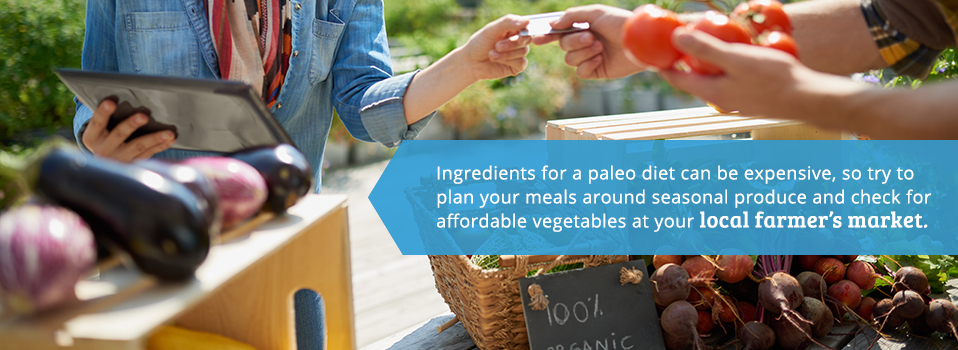
For example:
- Buy meat in bulk whenever possible. Freeze your purchases in individual portions. If you don’t have freezer space, consider splitting the cost of your purchase with a friend who also wants to follow a Paleo diet.
- Plan your meals around seasonal produce.
- Look for affordable veggies at your local farmer’s market.
- Purchase frozen veggies when you can’t afford fresh produce.
- If you have space for a garden, consider growing some of the veggies you enjoy the most.
- Try participating in a farm share or local CSA program.
Another great way to save money while on the Paleo diet is by cooking all your meals at home. Xtrema ceramic cookware makes this easy to do by offering a convenient, eco-friendly and chemical-free way to prepare your meals. It’s safe on glass, electric and gas stoves, as well as in the regular oven or toaster oven. You can even use your Xtrema cookware on the grill for a summer picnic.
With every delicious meal you make, you’ll be one step closer to the trim and healthy beach body of your dreams.
